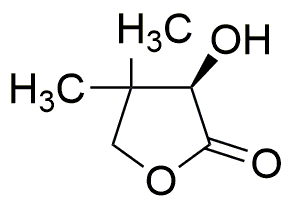D-(-)-Pantolactone is widely utilized in research focused on:
- Pharmaceutical Development: This compound serves as a precursor in the synthesis of pantothenic acid (Vitamin B5), which is essential for various metabolic processes in humans.
- Cosmetic Formulations: Due to its moisturizing properties, it is incorporated into skincare products to enhance hydration and improve skin texture, making it popular in the beauty industry.
- Food Industry: It acts as a flavoring agent and is used in food products to enhance taste and aroma, providing a natural alternative to synthetic additives.
- Agricultural Applications: D-(-)-Pantolactone is explored for its potential use in developing plant growth regulators, which can improve crop yield and resilience.
- Research in Biochemistry: It is utilized in various biochemical assays and studies to understand metabolic pathways, offering insights into cellular processes and disease mechanisms.
General Information
Properties
Safety and Regulations
Applications
D-(-)-Pantolactone is widely utilized in research focused on:
- Pharmaceutical Development: This compound serves as a precursor in the synthesis of pantothenic acid (Vitamin B5), which is essential for various metabolic processes in humans.
- Cosmetic Formulations: Due to its moisturizing properties, it is incorporated into skincare products to enhance hydration and improve skin texture, making it popular in the beauty industry.
- Food Industry: It acts as a flavoring agent and is used in food products to enhance taste and aroma, providing a natural alternative to synthetic additives.
- Agricultural Applications: D-(-)-Pantolactone is explored for its potential use in developing plant growth regulators, which can improve crop yield and resilience.
- Research in Biochemistry: It is utilized in various biochemical assays and studies to understand metabolic pathways, offering insights into cellular processes and disease mechanisms.
Documents
Safety Data Sheets (SDS)
The SDS provides comprehensive safety information on handling, storage, and disposal of the product.
Product Specification (PS)
The PS provides a comprehensive breakdown of the product’s properties, including chemical composition, physical state, purity, and storage requirements. It also details acceptable quality ranges and the product's intended applications.
Certificates of Analysis (COA)
Search for Certificates of Analysis (COA) by entering the products Lot Number. Lot and Batch Numbers can be found on a product’s label following the words ‘Lot’ or ‘Batch’.
*Catalog Number
*Lot Number
Certificates Of Origin (COO)
This COO confirms the country where the product was manufactured, and also details the materials and components used in it and whether it is derived from natural, synthetic, or other specific sources. This certificate may be required for customs, trade, and regulatory compliance.
*Catalog Number
*Lot Number
Safety Data Sheets (SDS)
The SDS provides comprehensive safety information on handling, storage, and disposal of the product.
DownloadProduct Specification (PS)
The PS provides a comprehensive breakdown of the product’s properties, including chemical composition, physical state, purity, and storage requirements. It also details acceptable quality ranges and the product's intended applications.
DownloadCertificates of Analysis (COA)
Search for Certificates of Analysis (COA) by entering the products Lot Number. Lot and Batch Numbers can be found on a product’s label following the words ‘Lot’ or ‘Batch’.
*Catalog Number
*Lot Number
Certificates Of Origin (COO)
This COO confirms the country where the product was manufactured, and also details the materials and components used in it and whether it is derived from natural, synthetic, or other specific sources. This certificate may be required for customs, trade, and regulatory compliance.


